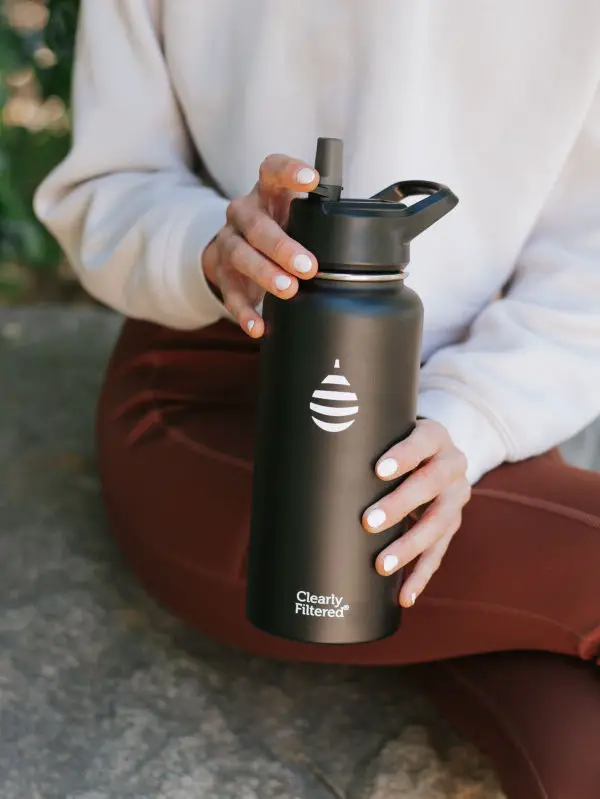The water that we drink isn’t always clean and safe. Fortunately, there’s a process called distillation that can remove most contaminants and make it safer to drink. So, what’s actually in distilled water then, other than just water?
Distilled water is water that has been purified by heating it to its boiling point, which causes it to turn into steam. The steam is then captured and cooled, which makes it condense back into water. This process removes contaminants from the water, leaving behind a pure, clear liquid.
But what exactly does distilled water contain, and what doesn’t it contain? Let’s take a closer look.
What’s Not in Distilled Water

Here’s what you need to know about distilled water and why it’s often the perfect choice for your health:
Distilled water doesn’t contain any contaminants that have a boiling point below that of water. That means if a substance doesn’t boil or evaporate before water does, then it’s left behind and removed from your now clear, pure drinking water.
In fact, distilled water doesn’t contain many of the contaminants that can often be found in regular tap water.
Here are some of the most common contaminants that are not present in distilled water:
Fluoride
Fluoride is a mineral that is often added to tap water to help prevent tooth decay. While fluoride can be beneficial in small amounts, excessive consumption can lead to dental fluorosis, which can cause tooth discoloration and other dental problems.
Distilled water does not contain fluoride, making it a good choice for people who want to avoid excess fluoride intake.
PFAS
PFAS, or per- and polyfluoroalkyl substances, are a group of chemicals that are found in many consumer products, including nonstick cookware and food packaging.
These chemicals can leach into water sources and are linked to a variety of health problems, including cancer and thyroid disease. Distillation is effective at removing PFAS from water, making distilled water a safer choice for drinking and cooking.
Water Purification Guide has been sounding the alarm about these toxic chemicals, and the damage they can do to us. They have detailed information on which water filters can remove PFAS.
Phthalates
Phthalates are chemicals that are commonly used in plastic products, such as water bottles and food containers.
These chemicals can leach into water, even into bottled water, and are linked to a variety of health problems, including reproductive issues and developmental problems in children. Distillation removes phthalates from water, making distilled water a safer choice for people who want to avoid exposure to these harmful chemicals.
Microplastics
Microplastics are small pieces of plastic that are found in all types of water, including tap water. These tiny particles are also harmful to aquatic life and can also pose a risk to human health.
While distillation is not specifically designed to remove microplastics, it can be effective at reducing their presence in water, helping us to reduce our exposure to these harmful particles.
Heavy Metals
Heavy metals are a group of metals that can be found in most water sources. These are metals like lead, mercury, and arsenic.
Exposure to these metals can lead to a variety of health problems, including neurological damage and cancer. Distillation is effective at removing most heavy metals from water, including lead, arsenic and iron.
Pesticides and herbicides
Pesticides and herbicides are chemicals that are used to kill pests and weeds. These chemicals can leach into water sources and are linked to a variety of health problems, including cancer and reproductive issues.
Distillation is effective at removing many pesticides and herbicides from water, but not all.
Minerals
Distillation removes almost all minerals, especially calcium, magnesium, sodium, fluoride, and potassium.
Salts are also easily removed by distillation, making it a great water purification option if you live in an area where the drinking water, or well water is brinier that you would like.
Hormones
Hormones are chemicals that are produced by the body and are involved in many different bodily functions. However, some hormones are also be found in water sources, particularly in areas where there are high concentrations of livestock.
Exposure to hormones in water can lead to a variety of health problems, including hormonal imbalances. Distillation is effective at removing some hormones from water, but there are many that we still don’t know much about.
Here are some examples of contaminants (and their boiling points) that are removed during distillation. Remember if they don’t evaporate before water does (at 100°C/212°F), then they are removed by distillation.
| Contaminant | Boiling Point |
| Lead | 1,740°C / 3,180°F |
| Mercury | 356.73°C / 674.1°F |
| Cadmium | 767°C / 1,412°F |
| Arsenic | 613°C / 1,135°F |
| Chromium | 2,672°C / 4,841°F |
| Nickel | 2,732°C / 4,946°F |
| Zinc | 907°C / 1,665°F |
| Copper | 2,562°C / 4,644°F |
| Iron | 2,862°C / 5,184°F |
| Aluminum | 2,519°C / 4,478°F |
| PFAS | 200-300°C / 400-572°F |
| Phthalates | 250-390°C / 480-734°F |
| Pesticides and herbicides | 100-300°C / 212- 572°F |
What is in Distilled Water?
So, what’s left in distilled water then?
Even though distilled water is free from many of the contaminants found in tap water, it’s not completely devoid of minerals and other substances.
In fact, it contains trace amounts of minerals such as calcium, magnesium, and potassium, as well as other substances that are not removed by distillation.
However, the levels of these substances are typically much lower than those found in tap water, and they are not harmful to human health. Actually, some people prefer the taste of distilled water over tap water because it has a cleaner and fresher taste.
Although, many only use distilled water for humidifiers, steamers, vaporizers, CPAPs and other appliances.
Here are some of the contaminants that are found in distilled water:
- Ammonia
- Chlorine
- Carbon dioxide
- Methane
- Formaldehyde
- Ethanol
- Acetone
- Ethyl acetate
- Benzene
Yet, because many of the minerals that give water it’s flavor have been removed, some people find distilled water tastes flat or bland. Water flavorings improve the taste of the water, and are easily added.
Also read about naturally sweet water flavorings here.
How To Get Distilled Water
If you are chasing distilled water for your home there are two options.
You can purchase bottles of distilled water, or a distiller. Each has their pros and cons. Buying bottles of distilled water is helpful because you only buy what you need. Unfortunately, it’s wasteful in terms of the overall cost, and the plastic that is wasted in every bottle.
On the other hand, buying a distiller can cost a couple of hundred dollars, and increases the cost of your electricity bill (though not by much).
Either way Amazon, Walmart, and many other shops have both options available and competitive prices.
Conclusion
Distilled water is a safe and pure alternative to tap water. It does not contain any of the harmful contaminants found in tap water, such as fluoride, chlorine, PFAS, phthalates, microplastics, heavy metals, and pesticides and herbicides.
While it may contain trace amounts of minerals and other substances, these are typically not harmful to human health.
Distillation is an effective method of purifying water, and it is used in many industries and applications, including in the production of pharmaceuticals and electronics. If you are looking for a safe and pure source, consider using distilled water.
The Best Water Filter Bottle We’ve Ever Used
Clearly Filtered | Stainless Steel Filter Bottles
We really love these filter bottles for keeping your drinks cool and contaminant free! They remove 99.9% of over 220 contaminants and use BPA-free plastics and double-walled stainless steel to produce some awesome looking designs with numerous bottle sizes for every situation. You can find them at Clearlyfiltered.com

